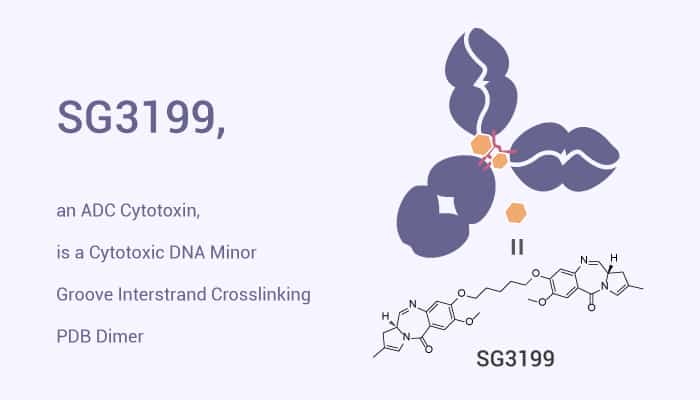The pyrrolobenzodiazepines (PBD) are a class of compound that may have antibiotic or anti-tumor properties. They exert their biological activity by binding in the minor groove of DNA. PBD dimers are a class of exquisitely potent DNA minor groove interstrand crosslinking agents. An important feature of the interstrand cross-links formed is that they cause minimal distortion of the DNA. In addition to interstrand cross-links, PBD dimers can also form sequence selective intrastrand cross-linked adducts and mono-alkylated adducts.
SG3199 is a cytotoxic DNA minor groove interstrand crosslinking pyrrolobenzodiazepine (PDB) dimer. Besides, SG3199 is the released warhead component of the ADC payload Tesirine (SG3249). In addition, in a variety of human solid tumors and haematological cancer cell lines, SG3199 has strong cytotoxicity. Generally, haematological cell lines are more sensitive to SG3199 than solid tumor cell lines. Moreover, SG3199 forms DNA interstrand cross-link in both naked DNA and cells. Furthermore, compared with CHO wild-type AA8 cells, cells defective in DNA repair protein ERCC1 or homologous recombination repair showed increased sensitivity to SG3199. In rats, intravenous (iv) administration of SG3199 showed a very rapid clearance with a half-life as short as 8 minutes. The very short half-life of SG3199 ensures that any premature release in circulation would also not result in accumulation of SG3199 to levels that cause systemic toxicity.

In summary, SG3199, a PBD dimer, is a warhead in next-generation ADCs with potently cytotoxic and a very short half-life.
References:
[1] John A Hartley, et al. Sci Rep. 2018 Jul 11;8(1):10479.
[2] Francesca Zammarchi, et al. Blood. 2018 Mar 8;131(10):1094-1105.